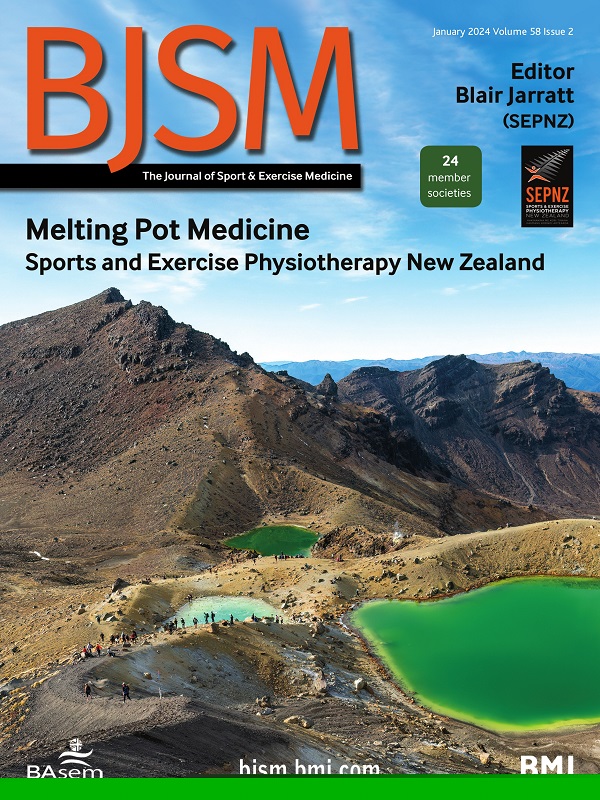ICON 2023: International Scientific Tendinopathy Symposium Consensus – the core outcome set for Achilles tendinopathy (COS-AT) using a systematic review and a Delphi study of professional participants and patients
IF 11.6
1区 医学
Q1 SPORT SCIENCES
引用次数: 0
Abstract
To develop a core outcome set for Achilles tendinopathy (COS-AT) for use in clinical trials we performed a five-step process including (1) a systematic review of available outcome measurement instruments, (2) an online survey on truth and feasibility of the available measurement instruments, (3) an assessment of the methodological quality of the selected outcome measurement instruments, (4) an online survey on the outcome measurement instruments as COS and (5) a consensus in-person meeting. Both surveys were completed by healthcare professionals and patients. The Outcome Measures in Rheumatology guidelines with a 70% threshold for consensus were followed. We identified 233 different outcome measurement instruments from 307 included studies; 177 were mapped within the International Scientific Tendinopathy Symposium Consensus core domains. 31 participants (12 patients) completed the first online survey (response rate 94%). 22/177 (12%) outcome measurement instruments were deemed truthful and feasible and their measurement properties were evaluated. 29 participants (12 patients) completed the second online survey (response rate 88%) and three outcome measurement instruments were endorsed: the Victorian Institute of Sports Assessment-Achilles questionnaire, the single-leg heel rise test and evaluating pain after activity using a Visual Analogue Scale (VAS, 0–10). 12 participants (1 patient) attended the final consensus meeting, and 1 additional outcome measurement instrument was endorsed: evaluating pain during activity/loading using a VAS (0–10). It is recommended that the identified COS-AT will be used in future clinical trials evaluating the effectiveness of an intervention. This will facilitate comparing outcomes of intervention strategies, data pooling and further progression of knowledge about AT. As COS-AT is implemented, further evidence on measurement properties of included measures and new outcome measurement instruments should lead to its review and refinement.ICON 2023:国际科学肌腱病研讨会共识--跟腱病核心结果集 (COS-AT),通过对专业参与者和患者进行系统回顾和德尔菲研究得出结论
为了开发用于临床试验的跟腱病核心结果集(COS-AT),我们进行了五步流程,包括:(1)对现有结果测量工具进行系统回顾;(2)对现有测量工具的真实性和可行性进行在线调查;(3)对所选结果测量工具的方法学质量进行评估;(4)对作为 COS 的结果测量工具进行在线调查;(5)召开一次达成共识的现场会议。这两项调查均由医护人员和患者完成。我们遵循了《风湿病学结果测量指南》的规定,共识的阈值为 70%。我们从 307 项纳入的研究中确定了 233 种不同的结果测量工具;其中 177 种被映射到国际科学腱鞘炎研讨会共识核心领域中。31 名参与者(12 名患者)完成了首次在线调查(回复率为 94%)。22/177(12%)项结果测量工具被认为真实可行,并对其测量特性进行了评估。29 名参与者(12 名患者)完成了第二次在线调查(回复率为 88%),并认可了三种结果测量工具:维多利亚运动评估研究所-跟腱问卷、单腿跟腱抬高测试和使用视觉模拟量表(VAS,0-10)评估活动后疼痛。12 名与会者(1 名患者)参加了最终的共识会议,会议还认可了另外一种结果测量工具:使用视觉模拟量表(VAS,0-10)评估活动/负重期间的疼痛。建议在未来评估干预效果的临床试验中使用已确定的 COS-AT。这将有助于比较干预策略的结果、汇集数据和进一步增进对反关节炎的了解。随着 COS-AT 的实施,有关所含测量指标的测量特性和新的结果测量工具的进一步证据应有助于对其进行审查和完善。
本文章由计算机程序翻译,如有差异,请以英文原文为准。
求助全文
约1分钟内获得全文
求助全文
来源期刊
CiteScore
27.10
自引率
4.90%
发文量
217
审稿时长
3-8 weeks
期刊介绍:
The British Journal of Sports Medicine (BJSM) is a dynamic platform that presents groundbreaking research, thought-provoking reviews, and meaningful discussions on sport and exercise medicine. Our focus encompasses various clinically-relevant aspects such as physiotherapy, physical therapy, and rehabilitation. With an aim to foster innovation, education, and knowledge translation, we strive to bridge the gap between research and practical implementation in the field. Our multi-media approach, including web, print, video, and audio resources, along with our active presence on social media, connects a global community of healthcare professionals dedicated to treating active individuals.

 求助内容:
求助内容: 应助结果提醒方式:
应助结果提醒方式:


